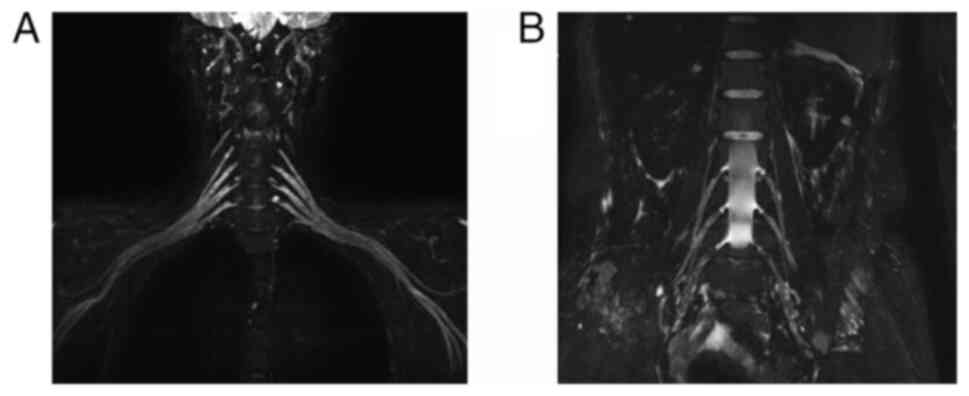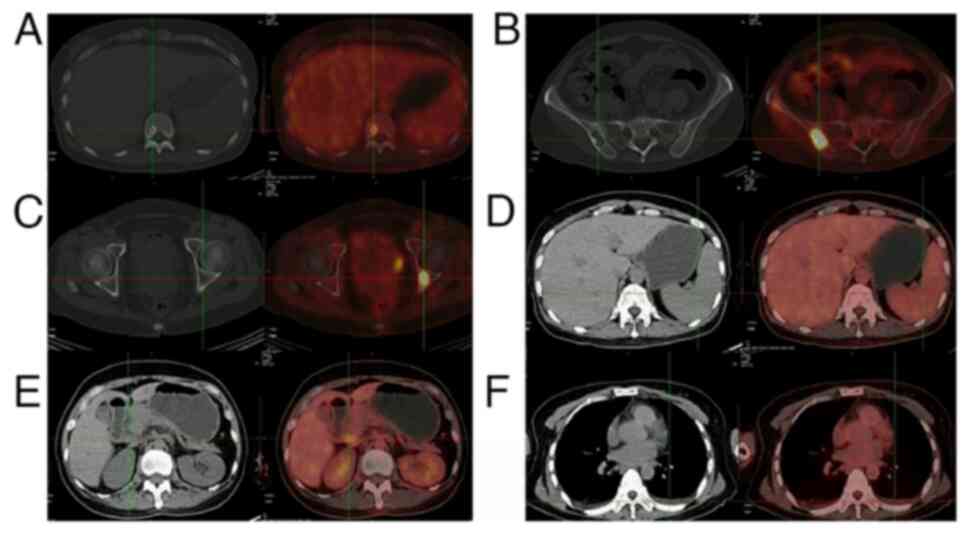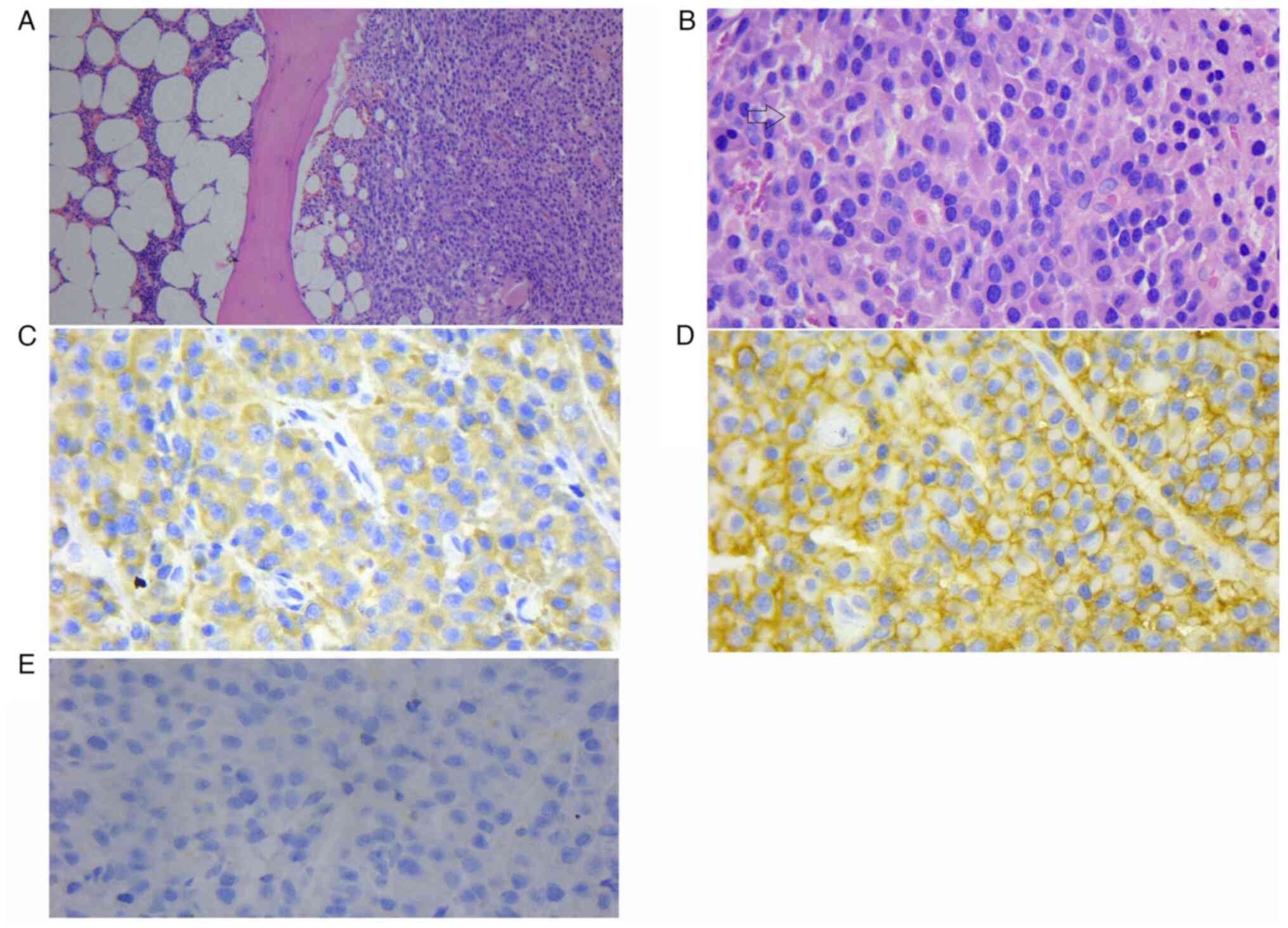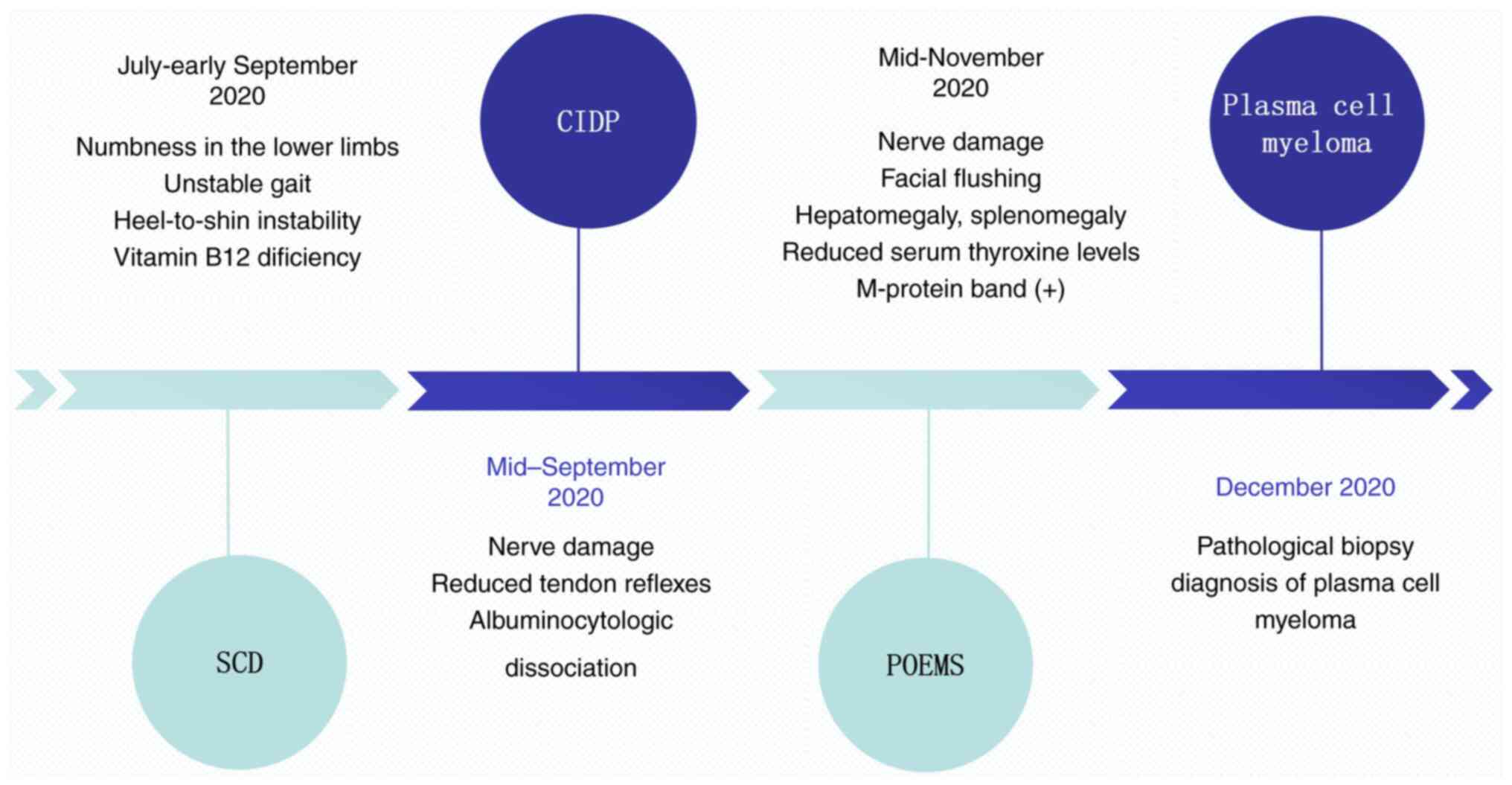Plasma cell myeloma with an evolving diagnostic complexity: A case report
- Authors:
- Published online on: April 7, 2025 https://doi.org/10.3892/ol.2025.15018
- Article Number: 272
-
Copyright: © Wu et al. This is an open access article distributed under the terms of Creative Commons Attribution License.
Abstract
Introduction
Peripheral neuropathy is among the most common and frequently encountered neurological conditions. Notably, multiregional epidemiological studies have reported that the prevalence of peripheral neuropathy increases with age, ranging from 1–3% in the general population and increasing to 7% in individuals >50 years of age (1). Although peripheral neuropathy is highly prevalent, it can be triggered by a wide range of causes (2). Clinically, neurologists often manage diverse presentations of peripheral neuropathy, including diabetic peripheral neuropathy indicated by foot numbness in diabetes mellitus, chemotherapy-induced peripheral neuropathy in patients with cancer, or Guillain-Barré syndrome marked by abrupt limb weakness and respiratory difficulty (3). Notably, thorough screening of the underlying causes is crucial in the accurate diagnosis and effective treatment of peripheral neuropathy; however, determining the cause can be challenging and the outcome is sometimes unexpected (4). The present study describes the complex diagnosis of a patient with plasma cell myeloma, who initially presented with peripheral neuropathy upon admission to Hainan Hospital of Chinese PLA General Hospital (Sanya, China).
Case report
A 48-year-old woman was admitted to Hainan Hospital of Chinese PLA General Hospital in September 2020 with a 2-month history of lower limb numbness and gait instability. The patient first noticed numbness in both feet in July 2020, which progressively worsened and spread further. By early September 2020, the numbness extended to the knees, further compromising their gait stability. The patient had been in good health prior to this episode. Upon admission, neurological examination showed clear consciousness, fluent speech and normal cognitive function. Cranial nerve assessment revealed no abnormalities. Muscle strength was grade 5 in all four limbs (5), with normal muscle tone. Pain and temperature sensations were intact in the upper limbs, but diminished in a stocking-like distribution in the lower limbs, accompanied by reduced vibration sense below the ankles. Finger-to-nose testing was accurate, although heel-to-shin testing showed instability. Deep tendon reflexes were normal in all four limbs. The patient exhibited a broad-based gait, a positive Romberg sign and bilateral pathological reflexes (6). Laboratory evaluations revealed a reduced vitamin B12 level, whereas other tests, such as blood chemistry, thyroid function and tumor markers, were within normal limits (Table I). Nerve conduction studies indicated peripheral nerve impairment in the lower limbs. Sensory nerve conduction was absent and motor nerve conduction velocity was markedly reduced in the lower limbs. Imaging evaluations, such as brain, cervical, thoracic and lumbar magnetic resonance imaging (MRI); lung and abdominal CT; and thyroid and vascular ultrasound, showed no notable abnormalities. Based on the clinical presentation and physical examination of the patient, they were initially diagnosed with subacute combined degeneration (SCD). Since the patient initially declined a lumbar puncture, methylcobalamin (500 µg intramuscular injection once a day), vitamin B1 (100 mg intramuscular injection once a day), vitamin B6 (10 mg orally twice a day) and folic acid (5 mg orally once a day), were administered.
Despite treatment, the symptoms worsened, leading to severe weakness in all four limbs. By mid-September 2020, muscle strength had declined to grade 4 in the distal upper limbs and grade 3 in the distal lower limbs, accompanied by reduced deep tendon reflexes in all four limbs. Given the ongoing deterioration, the patient ultimately agreed to undergo a lumbar puncture, which revealed albuminocytologic dissociation in the cerebrospinal fluid. All other cerebrospinal fluid parameters, including biochemical markers (glucose, chloride and protein levels, detected using hexokinase, ion-selective electrode and immunoturbidimetry methods, respectively), immunoglobulins (IgA, IgM and IgG, detected using nephelometry) and smear tests (to detect bacteria, fungi, parasites, tuberculosis and cancer cells), were within normal values. Further investigations were carried out to refine the diagnosis. Autoimmune peripheral neuropathy antibody panels (GM1, GM2, GD1a, GD1b, etc., detected using western blotting), Langerhans cell-related antibodies (neurofascin 155, neurofascin 186, contactin-associated protein 1, human contactin 1, etc. detected using a cytometric bead array) and genetic screening for hereditary neuropathies (detected using high-throughput sequencing) were all negative. MRI of the brachial and lumbosacral plexuses showed mild nerve root thickening (Fig. 1). Integrating the cerebrospinal fluid results and imaging findings, a possible diagnosis of chronic inflammatory demyelinating polyneuropathy (CIDP) was arrived at. The treatment regimen was revised to include high-dose methylprednisolone pulse therapy (initially 1 g/day with gradual tapering) in combination with intravenous (IV) immunoglobulin at 0.4 g/kg for 5 days. Following this therapy, the symptoms of the patient markedly improved. At discharge, muscle strength had improved to grade 5− in the distal upper limbs and grade 4+ in the distal lower limbs. Although the area of numbness remained largely unchanged, its severity had diminished.
Notably, the clinical symptoms of the patient flared again in mid-to-late November 2020, culminating in a second hospitalization in early December 2020. In contrast to their first admission, the second hospital stay was marked by hyperhidrosis, dry mouth, facial flushing, muscle atrophy and reduced muscle tone on physical examination. Muscle strength was grade 4 in the proximal limbs, grade 4 in the distal upper limbs and grade 2 in the distal lower limbs. Deep tendon reflexes were absent across all four limbs. Laboratory tests indicated thrombocytosis (514×109/l, reference values: 100–300×109/l) and a decreased serum thyroxine level (61.27 nmol/l, reference values: 66–181 nmol/l) (Table I). Cerebrospinal fluid analysis continued to show albuminocytologic dissociation (CSF white cell count, 1×106/l; protein, 1,044 mg/l; Table I). Nerve conduction studies demonstrated marked sensory and motor nerve involvement in both upper and lower limbs, with the lower limbs more severely affected. In light of the notable progression of peripheral neuropathy following treatment and the involvement of multiple organ systems (endocrine, hematological and cutaneous), further specialized tests and evaluations were performed. A PET-CT scan uncovered multiple hypermetabolic lesions accompanied by sclerotic and osteolytic bone changes throughout the body, hepatomegaly, splenomegaly, multiple enlarged hypermetabolic lymph nodes in both supraclavicular regions, around the portal vein and in the retroperitoneum, as well as bilateral pleural effusions (Fig. 2). Serum protein electrophoresis revealed an M-protein band, and serum immunofixation electrophoresis indicated a monoclonal immunoglobulin of the IgG-λ subtype (data not shown). Vascular endothelial growth factor (VEGF) concentration was 998 pg/ml (reference values: 0–300 pg/ml, detected by ELISA (cat. no. KL-VEGF-Hu; Shanghai KangLang Biological Technology Co., Ltd.], according to the manufacturer's protocol. Integrating the clinical features with these findings led to a suspected diagnosis of polyneuropathy, organomegaly, endocrine dysfunction, monoclonal plasma cell proliferation and skin changes syndrome (POEMS syndrome). A pathological biopsy, including H&E (Wuhan Jinhong Biotech Development Co., Ltd.), lambda (cat. no. 760-2515; Roche Tissue Diagnostics), CD38 (cat. no. ZM-0422; OriGene Technologies, Inc.) and kappa (cat. no. 760-2514; Roche Tissue Diagnostics) staining of the iliac lesion was performed (7). Kappa and lambda stains are immunoglobulin light chains used primarily to diagnose hematological diseases. The final pathological diagnosis of this patient was plasma cell myeloma. (Fig. 3).
In the current case report, the patient initially presented with peripheral neuropathy, and underwent a long and complex diagnostic and therapeutic course, initially being considered for SCD, CIDP and POEMS syndrome, before ultimately receiving a definitive diagnosis of plasma cell myeloma (Fig. 4). The patient was then transferred to the hematology department to receive combination therapy with bortezomib (1.3 mg/m2 IV on days 1, 4, 8 and 11), lenalidomide (25 mg/day orally on days 1–21) and dexamethasone (20 mg/day orally on days 1–4, 8–11 and 15–18), for a total of three cycles, in conjunction with early rehabilitation intervention. Since then, the patient was last followed up in June 2024 and has been followed up for a cumulative total of 3.5 years, during which early diagnosis and timely, comprehensive treatment has allowed them to regain independence in daily activities. In addition, their limb strength has substantially improved, enabling the patient to run and hike on their own, with only mild residual sensory deficits.
Discussion
Peripheral neuropathy has a notably high incidence in the general population and ranks among the most frequently encountered neurological conditions. Its underlying causes are highly diverse, and may involve factors such as nutritional deficiencies, chronic diseases, environmental toxins, prolonged alcohol misuse, genetic predisposition and medication-related side effects (8–11). In rare cases, peripheral neuropathy may be the starting form of a tumor. Nonetheless, diagnosing and treating peripheral neuropathy can be challenging, and in up to 25% of cases, the underlying cause remains elusive (12).
During the initial phase of peripheral neuropathy, patients frequently exhibit non-specific clinical symptoms and ancillary test findings. To some degree, the clinical manifestations and auxiliary evaluations may misdirect the diagnostic process. In the present case, the patient initially manifested with ataxia and severe sensory deficits in both lower limbs. Laboratory results demonstrated vitamin B12 deficiency, while nerve conduction studies revealed peripheral nerve impairment in the lower limbs. SCD is primarily characterized by deficits in proprioception and vibratory sensation, often accompanied by ataxia and gait disturbances, symptoms closely mirroring the initial presentation of the current patient (13).
Notably, as the condition evolved, the current patient acquired marked sensorimotor deficits in the limbs, diminished tendon reflexes and albuminocytologic dissociation in the cerebrospinal fluid. Accordingly, the diagnosis was modified to CIDP. Classical CIDP symptoms consist of progressively worsening sensory disturbances and limb weakness, potentially accompanied by muscle atrophy, reduced muscle tone and diminished tendon reflexes (14). In patients with CIDP, cerebrospinal fluid analysis frequently demonstrates albuminocytologic dissociation (15,16). Electromyographic evaluation typically indicates multifocal peripheral neuropathy in the upper and lower limbs, involving both sensory and motor fibers, with evidence of demyelination often coexisting with axonal damage. Notably, after treatment with immunoglobulin and methylprednisolone, the symptoms of the patient were markedly improved, reinforcing the provisional diagnosis of CIDP and inadvertently leading to de-prioritization of additional evaluations for alternative conditions.
POEMS syndrome is an uncommon paraneoplastic disorder linked to monoclonal plasma cell proliferation. Its incidence is low, and its initial presentation can be complex and varied, often with limited clinical specificity and a wide range of severity (17). Although the precise etiology and pathogenesis of POEMS syndrome remain incompletely clarified, research has suggested potential associations with monoclonal plasma cell hyperplasia, translocation at chromosome 14q32 and deletion of 13q14, Epstein-Barr virus and human herpesvirus 8 infections, proinflammatory cytokines, and VEGF. POEMS syndrome is mainly characterized by multisystem involvement. In the present case, comprehensive follow-up and additional evaluations demonstrated peripheral nerve involvement, hepatomegaly, splenomegaly, lymph node enlargement, thyroid hormone abnormalities, clonal plasma cell disease and cutaneous changes. Other notable features included pleural effusion, thrombocytosis, hyperhidrosis and reduced vitamin B levels, leading to the conclusion that the patient fulfilled the criteria for POEMS syndrome.
The diagnostic criteria for POEMS syndrome are as follows: i) Mandatory criteria: multiple instances of peripheral neuropathy and a monoclonal plasma cell proliferative disorder; ii) major criteria: Sclerotic bone lesions, Castleman's disease and elevated serum VEGF levels; iii) minor criteria: Organomegaly (involving the spleen, liver or lymph nodes), increased extravascular fluid volume, endocrine dysfunction, cutaneous changes, papilledema and thrombocytosis; and iv) other symptoms: Hyperhidrosis, weight loss, digital clubbing and pulmonary hypertension. A definitive diagnosis of POEMS syndrome calls for the presence of two mandatory criteria, at least one major criterion, and at least one minor criterion (18). In the present case, the patient fulfilled two mandatory criteria, one major criterion, four minor criteria and two additional symptoms, thereby meeting the diagnostic requirements for POEMS syndrome. In general, confirming a POEMS syndrome diagnosis can take upwards of 6 months; however, in this case, rigorous follow-up and prompt assessments narrowed that timeframe to just 3 months.
Notably, the clinical features of CIDP and POEMS syndrome are markedly similar, sharing a number of overlapping characteristics that frequently result in misdiagnoses (19,20). For example, both disorders manifest as multifocal peripheral neuropathies featuring gradually worsening sensorimotor deficits, with the lower limbs often more severely involved than the upper limbs. Sensory impairments generally follow a glove-and-stocking distribution, accompanied by pronounced muscle weakness, the principal contributor to disability. Laboratory evaluations show that patients with POEMS syndrome nearly always demonstrate albuminocytologic dissociation in the cerebrospinal fluid, a finding also noted in CIDP. Likewise, nerve conduction studies in both conditions can reveal multifocal peripheral nerve involvement, reduced conduction velocities in both motor and sensory fibers, and concomitant axonal damage. Pathological biopsies in both disorders commonly show axonal degeneration alongside segmental demyelination (19,20). Despite these similarities, key differences also exist between CIDP and POEMS syndrome. First, CIDP primarily affects peripheral nerves and may occasionally involve the cranial nerves, but generally does not produce the multisystem manifestations commonly seen in POEMS syndrome. By contrast, POEMS syndrome necessarily involves multiple organ systems in addition to peripheral neuropathy, although cranial nerve involvement is typically not observed. Furthermore, when compared with CIDP, nerve biopsies in POEMS syndrome indicate more pronounced axonal damage and more markedly reduced nerve conduction velocities (21).
M protein, which is essentially an immunoglobulin or immunoglobulin fragment, is produced by the clonal malignant proliferation of plasma cells or B lymphocytes. It is widely regarded as a key cornerstone in diagnosing POEMS syndrome and serves as one of the primary laboratory markers distinguishing POEMS syndrome from CIDP (22). Monoclonal gammopathy of undetermined significance (MGUS) refers to the presence of M protein in individuals without evidence of multiple myeloma, amyloidosis or other related diseases. M proteins are monoclonal immunoglobulins secreted by a neoplastic clone of plasma cells. In MGUS, these plasma cells are clonal but not malignant, whereas in multiple myeloma, macroglobulinemia and plasmacytoma, the clone has undergone malignant transformation (23). MGUS is also one of the important differential diagnoses of POEMS syndrome. MGUS is a premalignant precursor of multiple myeloma. Notably, patients with MGUS often present with peripheral neuropathy. MGUS can present with multisystemic manifestations due to monoclonal gammopathy, with the main clinical features manifesting as motor, sensory and autonomic dysfunction due to peripheral nerve damage (19). It is important to note that the combination of MGUS with peripheral neuropathy is predominantly seen in individuals >50 years of age. Despite the presence of protein M, MGUS is not associated with bone radiological or skin changes.
PET-CT serves a pivotal role in diagnosing POEMS syndrome (24). As a whole-body imaging technique that integrates morphological and cellular metabolic data, PET-CT provides substantial benefits for diagnosing and managing multisystem disorders. This modality can identify bone lesions in patients with POEMS syndrome early and comprehensively. These lesions primarily affect the spine, pelvis and ribs, exhibiting single or multiple nodular osteogenic or mixed destructive changes, sometimes with osteolytic lesions bordered by sclerotic margins. PET-CT also has considerable clinical utility for visualizing lymph node lesions, thus facilitating early identification of lymph nodes with abnormal metabolic activity (25). Additionally, it is highly valuable for guiding biopsy localization, given that sampling hypermetabolic bone lesions and lymph nodes can aid in establishing a diagnosis. In the present case, PET-CT offered critical insights into the overall metabolic status of the patient and informed the selection of an appropriate biopsy site.
In summary, the present study provides a review of a rare case of plasma cell myeloma that initially mimicked SCD and CIDP, subsequently evolving into POEMS syndrome. This case highlights the complexity and multiple challenges in the diagnosis and treatment of plasma cell myeloma, and suggests that neurologists should be aware of the possibility of the tumor having a non-specific peripheral neuropathy as its starting form. Furthermore, it underscores the need to screen for M protein, to conduct imaging to detect potential bone destruction, and, when indicated, to perform PET-CT to evaluate metabolic activity in patients with chronic peripheral neuropathies. For patients presenting with POEMS syndrome and bone destruction, timely pathological biopsy is essential to secure an early diagnosis and prevent delays in optimal treatment.
Notably, there are several limitations in the present case report. Although the presentation closely resembled SCD, CIDP and POEMS syndrome at various stages, this does not imply that all peripheral neuropathies manifest in such a manner; by contrast, this particular course of disease is rare among peripheral neuropathies.
In conclusion, diagnosing and treating peripheral neuropathy is inherently challenging because the early symptoms of numerous conditions associated with peripheral neuropathy are misleading. Clinicians need to be alert to the possibility of plasma cell myeloma with peripheral neuropathy as a form of disease initiation.
Acknowledgements
Not applicable.
Funding
Funding: No funding was received.
Availability of data and materials
The data generated in the present study may be requested from the corresponding author.
Authors' contributions
SW, JL and FC designed the report. TS, NZ, YL and JL investigated and followed up the patient. YL and TS supervised the project. SW, NZ and YL wrote the original draft. SW, NZ and JL reviewed, revised and edited the original draft. SW, NZ and JL confirmed the authenticity of all the raw data. All authors have read and approved the final version of the manuscript.
Ethics approval and consent to participate
Not applicable.
Patient consent for publication
Written informed consent was obtained from the patient for the publication of this case report and any accompanying images.
Competing interests
The authors declare that they have no competing interests.
Glossary
Abbreviations
Abbreviations:
|
SCD |
subacute combined degeneration |
|
CIDP |
chronic inflammatory demyelinating polyneuropathy |
|
MRI |
magnetic resonance imaging |
|
POEMS |
syndrome, polyneuropathy, organomegaly, endocrine dysfunction, monoclonal plasma cell proliferation and skin changes syndrome |
|
MGUS |
monoclonal gammopathy of undetermined significance |
References
|
Hanewinckel R, van Oijen M, Ikram MA and van Doorn PA: The epidemiology and risk factors of chronic polyneuropathy. Eur J Epidemiol. 31:5–20. 2016. View Article : Google Scholar : PubMed/NCBI | |
|
Callaghan BC, Price RS, Chen KS and Feldman EL: The importance of rare subtypes in diagnosis and treatment of peripheral neuropathy: A review. JAMA Neurol. 72:1510–1518. 2015. View Article : Google Scholar : PubMed/NCBI | |
|
Lehmann HC, Wunderlich G, Fink GR and Sommer C: Diagnosis of peripheral neuropathy. Neurol Res Pract. 2:202020. View Article : Google Scholar : PubMed/NCBI | |
|
McDonald CM: Clinical approach to the diagnostic evaluation of hereditary and acquired neuromuscular diseases. Phys Med Rehabil Clin N Am. 23:495–563. 2012. View Article : Google Scholar : PubMed/NCBI | |
|
Cuthbert SC and Goodheart GJ Jr: On the reliability and validity of manual muscle testing: A literature review. Chiropr Osteopat. 15:42017. View Article : Google Scholar : PubMed/NCBI | |
|
Lanska DJ and Goetz CG: Romberg's sign: Development, adoption, and adaptation in the 19th century. Neurology. 55:1201–1206. 2000. View Article : Google Scholar : PubMed/NCBI | |
|
Suvarna KS, Layton C and Bancroft JD: Bancroft's Theory and Practice of Histological Techniques. 7th Edition. Churchill Livingstone; 2012 | |
|
Rubens O, Logina I, Kravale I, Eglîte M and Donaghy M: Peripheral neuropathy in chronic occupational inorganic lead exposure: A clinical and electrophysiological study. J Neurol Neurosurg Psychiatry. 71:200–204. 2001. View Article : Google Scholar : PubMed/NCBI | |
|
Weimer LH: Medication-induced peripheral neuropathy. Curr Neurol Neurosci Rep. 3:86–92. 2003. View Article : Google Scholar : PubMed/NCBI | |
|
Ammendola A, Tata MR, Aurilio C, Ciccone G, Gemini D, Ammendola E, Ugolini G and Argenzio F: Peripheral neuropathy in chronic alcoholism: A retrospective cross-sectional study in 76 subjects. Alcohol Alcohol. 36:271–275. 2001. View Article : Google Scholar : PubMed/NCBI | |
|
López-Hernández N, García-Escrivá A, Pampliega-Pérez A, Alvarez-Saúco M, Martín-Estefanía C and Asensio-Asensio M: Peripheral and optical myeloneuropathy in a folic acid deficient alcoholic patient. Rev Neurol. 37:726–729. 2003.(In Spanish). PubMed/NCBI | |
|
Dyck PJ, Oviatt KF and Lambert EH: Intensive evaluation of referred unclassified neuropathies yields improved diagnosis. Ann Neurol. 10:222–226. 1981. View Article : Google Scholar : PubMed/NCBI | |
|
Hemmer B, Glocker FX, Schumacher M, Deuschl G and Lücking CH: Subacute combined degeneration: Clinical, electrophysiological, and magnetic resonance imaging findings. J Neurol Neurosurg Psychiatry. 65:822–827. 1998. View Article : Google Scholar : PubMed/NCBI | |
|
Stino AM, Naddaf E, Dyck PJ and Dyck PJB: Chronic inflammatory demyelinating polyradiculoneuropathy diagnostic pitfalls and treatment approach. Muscle Nerve. 63:157–169. 2021. View Article : Google Scholar : PubMed/NCBI | |
|
Illes Z and Blaabjerg M: Cerebrospinal fluid findings in Guillain-Barré syndrome and chronic inflammatory demyelinating polyneuropathies. Handb Clin Neurol. 146:125–138. 2017. View Article : Google Scholar : PubMed/NCBI | |
|
Dalakas MC, Latov N and Kuitwaard K: Intravenous immunoglobulin in chronic inflammatory demyelinating polyradiculoneuropathy (CIDP): Mechanisms of action and clinical and genetic considerations. Expert Rev Neurother. 22:953–962. 2022. View Article : Google Scholar : PubMed/NCBI | |
|
Brown R and Ginsberg L: POEMS syndrome: Clinical update. J Neurol. 266:268–277. 2019. View Article : Google Scholar : PubMed/NCBI | |
|
Dispenzieri A: POEMS syndrome. Blood Rev. 21:285–299. 2007. View Article : Google Scholar : PubMed/NCBI | |
|
Chaudhry HM, Mauermann ML and Rajkumar SV: Monoclonal gammopathy-associated peripheral neuropathy: Diagnosis and management. Mayo Clin Proc. 92:838–850. 2017. View Article : Google Scholar : PubMed/NCBI | |
|
Moshe-Lilie O, Ensrud E, Ragole T, Nizar C, Dimitrova D and Karam C: CIDP mimics: A case series. BMC Neurol. 21:942021. View Article : Google Scholar : PubMed/NCBI | |
|
Mauermann ML, Sorenson EJ, Dispenzieri A, Mandrekar J, Suarez GA and Dyck PJ and Dyck PJ: Uniform demyelination and more severe axonal loss distinguish POEMS syndrome from CIDP. J Neurol Neurosurg Psychiatry. 83:480–486. 2012. View Article : Google Scholar : PubMed/NCBI | |
|
Wang Q, Liu P, Ji LL, Wu S, Feng GD, Wang X and Dong JH: Clinical and electrophysiological profiles in early recognition of polyneuropathy, organomegaly, endocrinopathy, M-protein, and skin changes syndrome. Chin Med J (Engl). 132:1666–1672. 2019. View Article : Google Scholar : PubMed/NCBI | |
|
Kyle RA and Rajkumar SV: Monoclonal gammopathy of undetermined significance. Neoplastic Diseases of the Blood. Wiernik P, Goldman J, Dutcher J and Kyle R: 5th Edition. Springer; New York, NY: 2013, View Article : Google Scholar | |
|
Pan Q, Li J, Li F, Zhou D and Zhu Z: Characterizing POEMS syndrome with 18F-FDG PET/CT. J Nucl Med. 56:1334–1337. 2015. View Article : Google Scholar : PubMed/NCBI | |
|
Shi XF, Hu SD, Wu LL, Chen XY, Wu JN, Yu XQ, Li DY, Chen M, Liu YC, Zhu Y and Xi XD: Lymphadenopathy in POEMS syndrome: A correlation between clinical features and imaging findings. Int J Clin Exp Pathol. 13:21–25. 2020.PubMed/NCBI |














